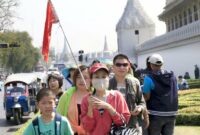Vacation Ideas for Senior Citizens: Planning the perfect getaway for senior travelers requires careful consideration of accessibility, comfort, and enriching experiences. This guide explores diverse domestic and international destinations, transportation options, budgeting strategies, and health & safety tips, ensuring a memorable and rejuvenating vacation tailored to the unique needs and preferences of senior citizens.
From exploring the stunning national parks of the United States to embarking on a culturally immersive European adventure, we delve into a range of options, providing practical advice and inspiring ideas to help seniors plan their dream vacation. We’ll cover everything from choosing senior-friendly accommodations and transportation to budgeting effectively and prioritizing health and safety during travel.
Domestic Travel Destinations for Seniors
Planning a domestic vacation offers seniors a wealth of options, balancing relaxation with exciting exploration while minimizing travel stress. Choosing the right location considers factors such as climate, accessibility, and the availability of attractions tailored to senior interests. This section highlights ideal destinations and resources to facilitate a smooth and enjoyable trip.
Ideal US States for Senior Travelers
The following table presents ten US states well-suited for senior travelers, considering climate, accessibility, and attractions. The selection balances diverse geographical locations and interests.
| State | Climate | Accessibility | Attractions |
|---|---|---|---|
| Florida | Warm, subtropical; potential for hurricanes | Generally good accessibility; many senior-friendly communities | Beaches, theme parks (with accessible options), natural springs |
| California | Varied; Mediterranean in south, cooler in north | Good accessibility in major cities; some rural areas less accessible | National parks (e.g., Yosemite, with accessible trails), beaches, diverse cities |
| Arizona | Hot, dry desert climate; mild winters | Good accessibility in major cities; some desert areas less accessible | Grand Canyon (with accessible viewpoints), Native American reservations, Sedona’s red rocks |
| Colorado | High-altitude; four distinct seasons | Good accessibility in major cities; mountainous areas can be challenging | Rocky Mountain National Park (with accessible trails), mountain towns, hot springs |
| Oregon | Mild, temperate; rainy season in winter | Good accessibility in major cities; some coastal areas less accessible | Oregon Coast (with accessible viewpoints), Crater Lake National Park, Portland’s gardens |
| Washington | Temperate; rainy season in winter | Good accessibility in major cities; some mountainous areas less accessible | Olympic National Park (with accessible trails), Seattle’s attractions, Puget Sound |
| South Carolina | Subtropical; humid summers, mild winters | Good accessibility in major cities; some coastal areas less accessible | Beaches, historic Charleston, plantations |
| Virginia | Four distinct seasons; humid summers | Good accessibility in major cities; some rural areas less accessible | Historic sites (e.g., Williamsburg), Shenandoah National Park, beaches |
| New Mexico | High desert; sunny days, cool nights | Good accessibility in major cities; some rural areas less accessible | Santa Fe’s art scene, Carlsbad Caverns, ancient pueblos |
| Maine | Four distinct seasons; cool summers, snowy winters | Good accessibility in major cities; some coastal areas less accessible | Acadia National Park (with accessible trails), charming coastal towns, lighthouses |
Accessible Accommodations for Seniors
Finding accommodations that cater to seniors’ needs is crucial for a comfortable trip. Several chains and independent establishments offer excellent senior-friendly amenities.
Here are five examples:
- The Phoenician, Scottsdale, Arizona: This luxury resort offers accessible rooms with roll-in showers, grab bars, and wider doorways. They also provide specialized services like wheelchair rentals and accessible transportation.
- The Lodge at Woodloch, Hawley, Pennsylvania: Known for its spa and wellness focus, this resort boasts accessible rooms with adaptive features and offers spa treatments designed for seniors.
- The Breakers Palm Beach, Florida: This iconic hotel offers accessible rooms and suites with features like roll-in showers, adjustable height beds, and visual alert systems.
- Hotel Nikko San Francisco, California: This hotel offers a variety of accessible rooms with features tailored to seniors, including grab bars, wider doorways, and visual aids. They also provide assistance with mobility.
- The Sanctuary Camelback Mountain Resort, Paradise Valley, Arizona: This luxury resort features accessible rooms, including those with roll-in showers and grab bars. They also provide accessible transportation around the resort.
Types of Senior-Friendly Tours within the US
Several tour operators specialize in creating itineraries and services tailored to the needs and preferences of senior travelers.
Three examples are:
- National Parks Tours: These tours often focus on accessible national parks, offering shorter, less strenuous hikes and utilizing accessible transportation. Pricing varies widely depending on the length and specific parks included, but generally range from $2000-$5000 per person for a week-long tour. Senior-specific services might include slower paces, accessible van transportation, and assistance with activities.
- Coastal Cruises: These tours offer relaxed itineraries with scenic coastal views, shorter excursions, and comfortable accommodations. Prices typically range from $3000-$8000 per person for a week-long cruise, depending on the ship and cabin class. Senior-specific services can include priority boarding, accessible cabins, and assistance with embarking/disembarking.
- Historical City Tours: These tours often focus on exploring historical cities with accessible transportation and shorter walking distances. Prices range from $1500-$4000 per person for a week-long tour, depending on the city and included activities. Senior-specific services often include slower paces, comfortable transportation, and assistance with navigating historical sites.
International Travel Options for Seniors
Exploring the world in retirement offers unparalleled opportunities for enriching experiences and creating lasting memories. Choosing the right destination, however, requires careful consideration of factors such as accessibility, healthcare provisions, and cultural compatibility. This section highlights international travel options specifically designed with the needs and preferences of senior travelers in mind.
Senior-Friendly Countries: Infrastructure, Cultural Attractions, Visa & Healthcare
Several countries stand out for their excellent infrastructure catering to seniors and their rich cultural attractions. These destinations offer a blend of ease of access and captivating experiences.
Below are three examples:
- Portugal: Portugal boasts a mild climate, beautiful coastal towns, and historic cities like Lisbon and Porto. Its cobblestone streets may present some challenges, but many areas are easily navigable. Visa requirements for most nationalities are straightforward, often involving a simple online application. Portugal has a national healthcare system, and private healthcare options are readily available, often with English-speaking staff. The country also offers a rich cultural tapestry, from Fado music to delicious cuisine, ensuring an immersive and enjoyable experience.
- Canada: Canada offers a welcoming atmosphere and a well-developed infrastructure for accessibility. Major cities like Toronto, Vancouver, and Quebec City provide excellent public transportation and accessible attractions. Visa requirements vary depending on nationality, but the application process is generally clear and efficient. Canada’s universal healthcare system provides comprehensive coverage for residents and visitors may access emergency medical services. The diverse landscapes and multicultural cities offer a variety of activities and attractions suitable for senior travelers.
- Japan: While navigating Japan might require more planning due to language barriers, the country’s meticulous attention to detail and efficient public transport make it surprisingly accessible. Japan Rail Pass can be beneficial for seniors. Visa requirements depend on nationality and the length of stay, so it’s crucial to check well in advance. Japan’s healthcare system is highly advanced, though language might be a barrier; travel insurance is strongly recommended. The country’s rich culture, stunning gardens, and delicious food offer a unique and unforgettable experience.
Sample Ten-Day European Tour for Seniors
This itinerary prioritizes a relaxed pace and minimizes strenuous activities, focusing on cultural immersion and comfortable travel.
The following itinerary is a suggestion, and adjustments can be made based on individual preferences and fitness levels.
- Days 1-3: Paris, France: Focus on accessible landmarks like the Eiffel Tower (consider pre-booking tickets to avoid long queues), the Louvre Museum (allocate sufficient time for rest breaks), and charming neighborhoods like Montmartre. Utilize the efficient Paris Metro system, but be mindful of stairs in some stations.
- Days 4-6: Amsterdam, Netherlands: Explore Amsterdam’s canals by boat (choose a wheelchair-accessible option if needed), visit the Anne Frank House (book tickets well in advance), and enjoy the city’s many museums at a leisurely pace. Amsterdam offers good accessibility, with many flat surfaces and good public transport.
- Days 7-9: Bruges, Belgium: Enjoy the charming canals and medieval architecture of Bruges. This smaller city is generally easier to navigate than larger capitals, with a slower pace of life. Consider horse-drawn carriage rides for a relaxing way to see the city.
- Day 10: Travel Day: Allow ample time for travel back home, accounting for potential delays.
Cost Comparison: Two International Destinations
Comparing the cost of travel between two destinations requires considering flights, accommodation, and activities. Let’s compare Portugal and Japan for a ten-day trip for two people.
These are estimates and can vary based on the time of year, booking in advance, and specific choices.
| Cost Factor | Portugal (Estimate) | Japan (Estimate) |
|---|---|---|
| Flights (round trip) | $1500 – $2500 | $3000 – $5000 |
| Accommodation (10 nights) | $1000 – $2000 (mid-range hotels) | $2000 – $4000 (mid-range hotels) |
| Activities & Food | $1000 – $2000 | $2000 – $4000 |
| Total Estimated Cost | $3500 – $6500 | $7000 – $13000 |
This comparison highlights that while Portugal offers a more budget-friendly option, Japan’s higher costs are largely due to international flights and generally higher prices for accommodation and activities.
Cruises and Other Transportation Methods
Choosing the right mode of transportation is crucial for a comfortable and enjoyable senior travel experience. Factors such as accessibility, amenities, and personal preferences play a significant role in determining the best option. This section will explore various transportation methods, highlighting their suitability for senior travelers, with a specific focus on the nuances of river and ocean cruises.
River Cruises versus Ocean Cruises for Senior Travelers
River cruises and ocean cruises both offer unique advantages and disadvantages for senior travelers. Accessibility and onboard amenities are key considerations. River cruises generally feature smaller ships, allowing for easier navigation and more intimate experiences. Embarkation and disembarkation are often simpler, with fewer stairs and closer proximity to shore excursions. Onboard amenities are typically tailored to a more relaxed pace, with fewer large-scale events and a greater emphasis on comfortable lounges and dining options. Ocean cruises, on the other hand, offer a wider range of destinations and onboard activities, but can be more challenging for seniors due to larger ship sizes and potentially longer distances between points of interest. Accessibility features can vary greatly between ocean cruise lines, so careful research is necessary. For example, some may have more accessible cabins and elevators, while others may lack sufficient ramps or accessible restrooms.
Transportation Options for Seniors: A Comparison
The following table compares different transportation options for seniors, considering their suitability for various travel styles.
| Transportation Method | Suitability for Independent Travel | Suitability for Group Travel | Accessibility Considerations |
|---|---|---|---|
| Train | High (depending on mobility) | High | Generally good accessibility, but check specific train lines and routes for features like accessible restrooms and boarding ramps. |
| Bus | Moderate (requires some mobility) | High | Accessibility varies greatly; check with the bus company for specific features and assistance. |
| Car (private or rental) | High (requires driving ability or companion) | Moderate | Accessibility depends on the vehicle; consider features like hand controls and ramps if needed. |
| Cruise Ship (Ocean/River) | High (with appropriate assistance if needed) | High | Accessibility varies significantly between lines and ship sizes; research specific accessibility features before booking. |
Features of a Senior-Friendly Cruise Line
Senior-friendly cruise lines prioritize accessibility, medical facilities, and entertainment options tailored to the needs and preferences of older travelers. Accessibility features might include wider doorways, ramps, elevators with sufficient space for wheelchairs, and accessible cabins with grab bars and roll-in showers. Comprehensive medical facilities, including a doctor and nurse on board, are crucial for peace of mind. Entertainment options may include gentler activities such as lectures, arts and crafts workshops, and low-impact exercise classes, in addition to more traditional stage shows and live music. For example, some cruise lines offer specialized programs designed for seniors, such as themed excursions and wellness activities. They may also offer shore excursions that are less strenuous and better suited to the physical capabilities of older adults. Furthermore, the availability of assisted mobility devices and dedicated staff to provide assistance are essential features for a truly senior-friendly cruise experience.
Budgeting and Planning for Senior Vacations
Planning a memorable and affordable vacation requires careful budgeting and meticulous planning, especially for senior travelers who may have specific needs and financial considerations. This section provides practical guidance on creating a realistic budget, step-by-step planning instructions, and strategies for leveraging senior discounts to maximize value.
Sample Seven-Day Vacation Budget for a Couple
This budget example assumes a moderate level of spending for a couple traveling domestically within the United States. Prices can vary significantly depending on location, time of year, and specific choices. This serves as a template; adjust figures based on your chosen destination and preferences.
| Expense Category | Estimated Cost |
|---|---|
| Round-trip Flights (2 people) | $800 |
| Accommodation (7 nights, mid-range hotel) | $1400 |
| Food (groceries & some restaurant meals) | $700 |
| Activities & Entrance Fees (museums, tours, etc.) | $400 |
| Transportation (local transport, taxis) | $200 |
| Souvenirs & Miscellaneous | $200 |
| Total Estimated Cost | $3700 |
Step-by-Step Vacation Planning Guide for Seniors
Thorough planning minimizes stress and maximizes enjoyment. This guide outlines a practical approach.
- Destination Selection: Research potential destinations considering accessibility, climate, and interests. Consider destinations known for senior-friendly amenities.
- Budget Determination: Create a detailed budget, allocating funds for each expense category. Utilize budgeting apps or spreadsheets for tracking.
- Travel Dates & Booking Flights: Book flights well in advance, especially during peak season, to secure the best fares. Consider off-season travel for lower costs.
- Accommodation Booking: Reserve accommodations that suit your needs – accessibility features, proximity to attractions, etc. Explore options like vacation rentals for potential cost savings.
- Travel Insurance Acquisition: Obtain comprehensive travel insurance covering medical emergencies, trip cancellations, and lost luggage. This is especially crucial for seniors.
- Packing Essentials: Pack light but strategically. Include necessary medications, comfortable walking shoes, and any assistive devices.
- Itinerary Creation: Plan a flexible itinerary, incorporating rest days and avoiding over-scheduling. Prioritize activities that align with your interests and physical capabilities.
Utilizing Senior Discounts and Travel Deals
Many travel providers offer discounts for senior citizens. Taking advantage of these can significantly reduce vacation costs.
- AARP Membership: AARP offers discounts on hotels, car rentals, and attractions. Membership fees are generally offset by savings.
- Airline Senior Discounts: Some airlines provide discounts for travelers aged 65 and above. Check directly with airlines for current offers.
- Hotel Senior Rates: Many hotels offer senior discounts, often ranging from 10% to 25% off the standard rate. Always inquire when booking.
- Attraction and Activity Discounts: Many museums, theme parks, and other attractions offer reduced admission fees for seniors. Check their websites or contact them directly.
- Travel Agencies Specializing in Senior Travel: These agencies often have access to exclusive deals and packages tailored to the needs and budgets of senior travelers.
Health and Safety Considerations
Planning a vacation, especially for senior citizens, requires careful consideration of health and safety. A well-planned trip minimizes risks and maximizes enjoyment, allowing seniors to focus on relaxation and creating lasting memories. This section addresses crucial aspects of maintaining well-being and ensuring safety during travel.
Medication Management While Traveling
Proper medication management is paramount for senior travelers. Before departure, consult your physician to obtain a comprehensive list of medications, including dosages and potential interactions. Pack medications in their original containers with labels clearly visible. Carry a sufficient supply for the entire trip, plus a few extra days’ worth in case of delays. Consider keeping a copy of your prescription information separate from your medication in case of loss or theft. For international travel, familiarize yourself with any necessary import regulations for your medications. Always keep your medications in your carry-on luggage to avoid potential loss or damage during checked baggage handling.
Hydration and Dietary Needs During Travel
Maintaining adequate hydration is crucial, particularly in warmer climates or during long journeys. Carry a reusable water bottle and refill it regularly. Consider packing electrolyte drinks or tablets to replenish fluids and electrolytes lost through perspiration. If you have specific dietary needs or restrictions, plan your meals accordingly. Research restaurants and food options in advance, and don’t hesitate to inform restaurant staff about any allergies or dietary requirements. Pack non-perishable snacks for unexpected situations or delays.
The Importance of Travel Insurance for Senior Travelers
Travel insurance is highly recommended, if not essential, for senior travelers. It provides financial protection against unforeseen circumstances such as medical emergencies, trip cancellations, lost luggage, and other unexpected events. Several types of coverage are available, including medical evacuation insurance, which can be particularly important for seniors with pre-existing health conditions. Comprehensive policies often include coverage for trip interruptions, baggage delays, and even personal liability. When choosing a policy, carefully review the terms and conditions, paying close attention to exclusions and limitations. Consider your specific needs and travel plans when selecting the appropriate level of coverage. For example, a trip to a remote location may require more extensive coverage than a domestic vacation.
Safety Precautions for Domestic and International Travel
Safety should be a top priority when traveling. For domestic travel, familiarize yourself with the local area before your trip. Inform family or friends of your itinerary and expected return time. Be aware of your surroundings and avoid walking alone in poorly lit or isolated areas, especially at night. When traveling internationally, research the local customs and laws. Be cautious of scams and avoid sharing personal information with strangers. Register with your country’s embassy or consulate before your departure, and keep copies of important documents such as your passport and travel insurance information in a safe place. Consider using reputable transportation services and avoiding unmarked taxis. If you feel unsafe or uncomfortable, seek assistance from local authorities or hotel staff.
Activities and Interests for Seniors on Vacation
Planning engaging and appropriate activities is crucial for a fulfilling senior vacation. The key is to balance relaxation with stimulating experiences, ensuring activities are enjoyable and manageable for varying levels of physical ability. A well-rounded itinerary caters to diverse interests, maximizing the enjoyment and creating lasting memories.
Relaxing and low-impact activities are essential for senior travelers, promoting well-being and preventing overexertion. These activities allow for gentle exploration and appreciation of the surroundings without compromising comfort or health. Many destinations offer opportunities for leisurely enjoyment, fostering a sense of rejuvenation and peace.
Relaxing and Low-Impact Activities
A range of options exist to ensure a relaxing and enjoyable vacation for senior travelers. These activities prioritize comfort and minimize physical strain, allowing for a fulfilling experience without excessive exertion.
- Gentle hikes on well-maintained trails, choosing shorter, less strenuous routes with minimal elevation changes. Many national parks offer accessible trails specifically designed for seniors and individuals with mobility challenges.
- Bird watching, a calming and engaging hobby that can be enjoyed in various locations, from tranquil gardens to bustling nature reserves. Binoculars and a field guide enhance the experience, allowing for identification and appreciation of diverse avian species.
- Visiting museums and art galleries, providing opportunities for intellectual stimulation and cultural immersion. Many museums offer accessible entrances, elevators, and seating areas to accommodate the needs of senior visitors.
- Relaxing spa treatments, such as massages and aromatherapy, promote relaxation and stress reduction. Many resorts and hotels cater specifically to senior travelers, offering specialized spa packages designed for relaxation and rejuvenation.
- Enjoying leisurely boat rides or scenic drives, offering panoramic views and opportunities for photography. These activities provide a sense of calm and allow for appreciation of the natural beauty of the surroundings.
Engaging Cultural Experiences
Cultural immersion offers a rich and rewarding experience for senior travelers, fostering intellectual curiosity and broadening perspectives. The following examples highlight accessible and historically significant sites suitable for seniors.
- The Palace of Versailles, France: This opulent palace offers a glimpse into French history and royal life. While extensive, the palace provides accessible routes and wheelchairs for visitors with mobility challenges. Audio guides are available in multiple languages, enriching the experience for international travelers.
- The Roman Forum, Italy: Exploring the ruins of this ancient city provides a fascinating journey through Roman history. While some areas may be uneven, paved walkways and accessible routes are available, allowing seniors to appreciate the grandeur of this historical site. Guided tours cater to diverse needs and provide historical context.
- The Smithsonian National Museum of Natural History, Washington D.C., USA: This museum offers a vast collection of artifacts and exhibits, covering a wide range of scientific and cultural topics. The museum is fully accessible, with ramps, elevators, and assistive devices available for visitors with disabilities.
- The Great Wall of China: While sections of the Great Wall can be challenging to navigate, certain restored sections offer accessible pathways and ramps, allowing seniors to experience this iconic landmark. Guided tours can be tailored to the physical capabilities of the group.
- The Alhambra, Spain: This breathtaking palace and fortress complex showcases Moorish architecture and artistry. While some areas may be challenging, the Alhambra offers accessible routes and adapted facilities, allowing seniors to appreciate its beauty and historical significance. Wheelchair rentals and guided tours are available.
A Relaxing Vacation Scene
Imagine a tranquil scene: Eleanor and Arthur, a retired couple, are seated on a sun-drenched veranda overlooking a serene vineyard in Tuscany. The warm afternoon sun bathes their faces in a golden glow. Eleanor sips a glass of chilled Pinot Grigio, its delicate aroma filling the air. Arthur gently strokes their fluffy white Maltese, Coco, who rests contentedly in his lap. The gentle breeze rustles the leaves of the ancient olive trees surrounding them, creating a soothing symphony of nature’s sounds. In the distance, the rolling hills are painted with the vibrant hues of the Tuscan countryside. A sense of profound peace and contentment permeates the air, a testament to the restorative power of a well-deserved vacation.
Final Review
Ultimately, planning a fulfilling vacation as a senior citizen is about prioritizing comfort, safety, and enriching experiences. By carefully considering the factors outlined in this guide – from destination selection and budget management to health considerations and activity choices – seniors can confidently embark on a memorable journey, creating lasting memories and enjoying well-deserved relaxation and adventure. Remember to tailor your trip to your specific needs and preferences, ensuring a truly personalized and enjoyable experience.




